
On June 23, 2022, I gave a talk at the National Library of Medicine in Bethesda, Maryland, titled “Merleau-Ponty, Descartes, and the Meaning of Painting.” The talk was based in part on research I’d done in the library’s rare book collection on first editions of the works of the French philosopher, René Descartes. The text of the talk, along with some of the images that accompanied it, are reproduced below.
Good afternoon.
I want to begin by thanking Jeff Reznick for the invitation to speak today. I also want to thank Patricia Brennan and Michael Chiang for attending. I’m honored by your presence. It’s also a great pleasure to see my friend and colleague, Shelly Lowe. Shelly, I’m excited by your appointment and grateful for the important work you’re doing as Chair of the National Endowment for the Humanities. The agency is in good hands. Last but certainly not least, thanks to all those tuning in today via Zoom. I’m grateful for your interest.
I’ll begin with a brief story. Sometime toward the beginning of my term as Chair of NEH, I was briefed on the important relationship between the agency and the National Library of Medicine. Jeff Reznick then invited me to visit the library. I spent a full morning there, meeting Jeff’s colleagues, touring the facility, and learning more about the library’s collaboration with NEH.
Prior to my visit, I knew almost nothing about the library. I was startled by the scope of the institution, its ambition, and its extraordinary resources. I was also struck by the library’s commitment to the history of medical science and practice, which connects it naturally to the humanities and the work of NEH. I was especially impressed by the archival materials held by the library, its impressive collection of rare and unique books, and the beautiful reading room where scholars can explore these and other remarkable materials.

One of the books on display in the reading room that day was the first French edition of René Descartes’s Discourse on Method and its attached essays, The Optics, The Meteorology, and The Geometry, published in Leiden, the Netherlands, in 1637, nearly 400 years ago. With barely contained excitement, I asked Jeff and his colleague Michael North if I might come back and spend time with this and other works by Descartes. “Of course,” they replied. “Give us several days’ notice so we can have everything ready for you.”
Some months later, I did go back. It was Friday, July 29, 2016. I know the date because I was permitted to take photographs of the works I’d requested, and they’re all date stamped. I spent the better part of a day in the reading room, pouring over the volumes I’d requested, and taking notes on my reactions. It was a rich and memorable experience.
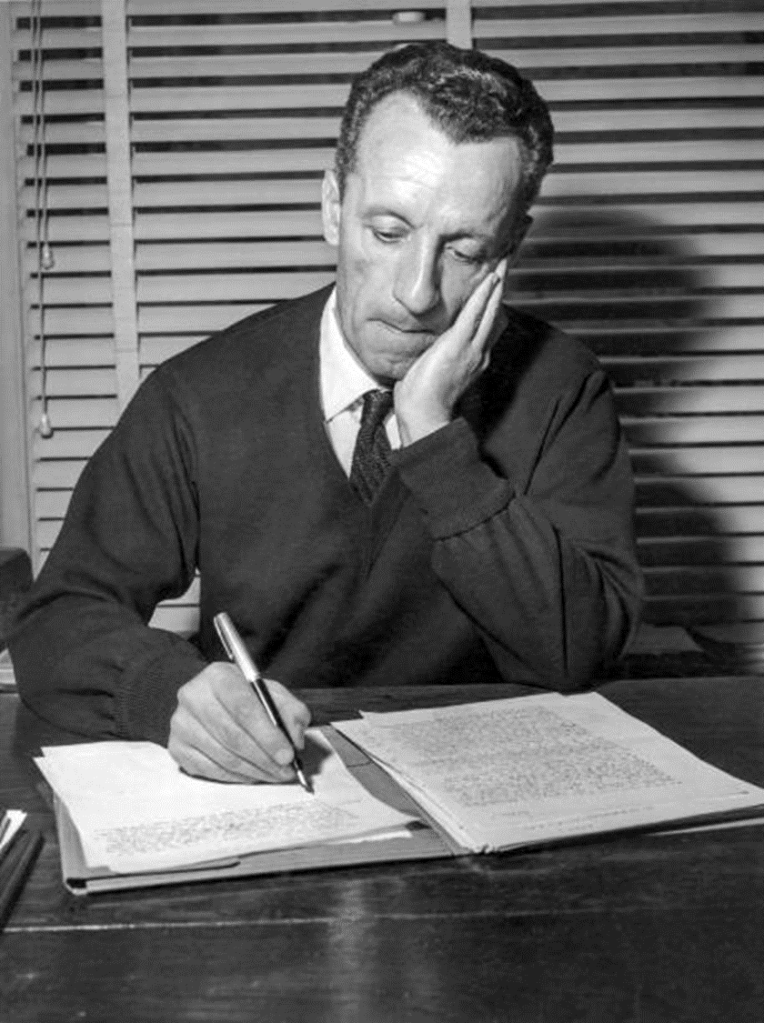
But why Descartes? Another story, and a bit of philosophy. Prior to joining NEH, I’d started work on a book — an awfully long book, as it turns out, still unfinished — about the French philosopher Maurice Merleau-Ponty and the French painter Paul Cézanne. The book is a dialogue across time (Cezanne and Merleau-Ponty were not contemporaries), rooted in the places in which they lived — Paris and southern France, principally — and the historical and social circumstances that influenced their work. The demands of my appointment at NEH caused me to suspend work on the book, but it was always in the back of my mind.
Merleau-Ponty was born in Rochefort-sur-Mer, France, in 1908. His family moved to Paris soon after, and he spent the remainder of his life there, teaching in the French university system and writing on a wide array of subjects, including philosophy, psychology, aesthetics, politics, and language. He was a central figure in the post-World War II existentialist movement that included Jean-Paul Sartre, Simone de Beauvoir, and Albert Camus, among others.
Merleau-Ponty’s philosophy is built around a single, extraordinarily rich insight. He articulated that insight in diverse ways over time, enriching and deepening its meaning and the language he used to express it, but never altering its fundamental sense and direction. His insight was this: “the perceived world — the world revealed to us by our senses and in daily life — is the always presupposed foundation of all reality, all value, and all existence.” Perception is the principal interest, then — the gold mine, the Holy Grail — of philosophy. All the great philosophical problems — the nature and origin of truth, the nature and origin of consciousness, the relationship between mind and body and mind and world, the nature of reality itself — lead back to perception. The ultimate task of philosophy is to reveal the inner workings of perception and to demonstrate how they ground and connect all facets of human life and experience, including the various domains of knowledge.

The epicenter of the perceived world, as Merleau-Ponty understood it, is the human body, which is the ultimate anchor and agent of perception. The human body is remarkable owing both to its manifold sensing powers, so perfectly tuned to the inspection and knowledge of the world, and to its capacity to coordinate and organize those powers in the seamlessness of perceptual experience. The body is all. This turn away from the traditional philosophical preoccupations with the mind or consciousness or ideas and toward the body is one of the most radical and important innovations in Merleau-Ponty’s philosophy.
Merleau-Ponty was intensely interested in all the perceptual powers and modalities of the body, but there is no question that the body’s power of vision, its power of seeing, was first among equals. Vision is special because it extends perceptual experience well beyond the perimeter of the body, permitting us to inspect and know the world at a distance. Vision is in this sense ecstatic, and Merleau-Ponty never ceased to express his wonder and amazement at the way in which the power of seeing thrusts us out into the world.
Given his interest in sense perception and the body, and especially in the body’s power of vision, it’s not surprising that Merleau-Ponty was deeply interested in painting, and especially in the painting of Paul Cézanne. He regarded painters, and Cézanne in particular, as fellow travelers in the largely unexplored terrain of perceptual life and vision. Beyond its immediate aesthetic power and appeal, painting had, for Merleau-Ponty, the deepest philosophical significance.
Exploring and describing our perceptual habitat, as he sometimes described it, would seem to be a straightforward matter. After all, it’s what we know best. But in fact, it’s not so easy. We are so at home in perceptual life and experience, so accustomed to its richness and complexity, so deeply embedded in its constant achievements, that we never really see it for what it is. We are also burdened by several cultural traditions and expectations regarding what is required to know something. And one of the most profound and persistent is the systematic skepticism we’ve been encouraged to apply to the world of appearances and what we know of the world through our senses.

Enter Descartes. As an aspiring young French philosopher in the 1920s, Merleau-Ponty would certainly have been expected to know Descartes. But across his career, Descartes had special and enduring significance. He refers to him constantly in his early works on perception, and in the last years of his life, he returned to a deep exploration of Descartes’s metaphysics and his theories of vision and light in his teaching at the Collège de France and in his last book, Eye and Mind, a work on vision and painting. A copy of Descartes’s treatise on vision — La Dioptrique — was found on the desk in the study where Merleau-Ponty died suddenly from a massive heart attack on May 3, 1961.
Merleau-Ponty’s interest in Descartes was deeply ambivalent. On the one hand, he admired Descartes’s extraordinary ambition and his reflective cast of mind. Descartes’s first question — who and what am I, this being who thinks about the world and himself — is a touchstone for every important philosophical endeavor. On the other hand, Merleau-Ponty believed that the answers Descartes gave to these questions were deeply flawed. “Descartes went so far as to say that by simply scrutinizing objects… I am able to discover that my senses deceive me, and I learn only to trust my intellect.” Henceforth, the only dependable sources of truth and certainty are the “clear and distinct ideas” the mind arrives at after it withdraws from experience and turns toward the clarity of purely rational constructions. In the wake of this skeptical and rationalist turn, a series of deeply problematic dualisms — mind and body, subject and object, mind and matter, thinking substance and extended substance — begin to assert themselves in the forward progress of European philosophy and science. In Merleau-Ponty’s view — the modern world, our world — is one characterized by the cultural implantation of these dualisms and by the accelerating divergence of the methods and findings of natural science from perceptual life and experience.
Merleau-Ponty was especially interested in the implications of Descartes’s rationalism for understandings of the human body and vision. As a part of the material world — of the res extensa, as he called it — Descartes concluded that animal and human bodies could be thought of as mechanical systems or machines. And like every other part of the material world, those systems can be comprehended in strictly mechanical terms. Vision is a good example. We see the world, or we have images of the world, Descartes argued, owing to the mechanical effects of light waves on the optical machinery of the eye. The mind — the res cogitans — then receives and interprets these physical signals, creating the images that constitute sight. Descartes proposed that we think of sight as analogous to what happens when a blind person uses a cane to negotiate the world of objects. When it touches an object, the cane transmits a physical impulse along its length to the hand, from the hand to the arm, from the arm to the brain, and so on, until the signal is decoded, as it were, by the mind, where an image of the object is finally formed. “The Cartesian concept of vision,” Merleau-Ponty notes, “is modeled after the sense of touch.”
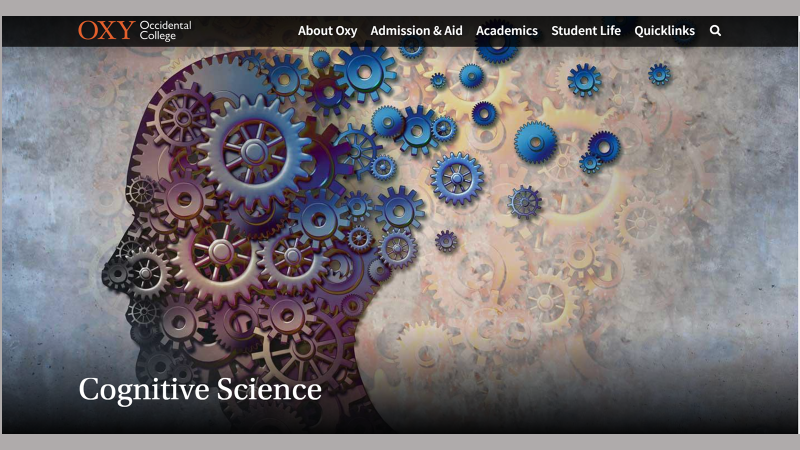
Thinking of the body as a mechanical device or a machine may seem odd to us. Owing to the predominance of cell biology and biochemistry in medicine, we are inclined toward more organic models. But the mechanical view is still very much present in certain forms of cognitive science, where the brain is modeled as a digital machine, a computer, and thinking as a form of digital processing. Descartes is the ghost in the machine of Artificial Intelligence.
On the day I played hooky from NEH, I arrived early at the library’s reading room and found several volumes of Descartes’s works waiting for me. They included the first French edition of Descartes’s first published book, The Discourse on Method, with its attached essays, The Optics, The Meteorology, and The Geometry, published in Leiden in 1637; the first Latin edition of The Discourse and Essays, published in Leiden in 1664, and the first French and Latin editions of The World and Of Man, published in Paris in 1664, more than a decade after Descartes’s death.

I had several strong sensations as I began looking through these works. In a way I could not have anticipated, it was thrilling to hold these objects, so close in space and time to the moment and source of their creation, and so distant from our current circumstances. It’s not just that they look old (they do, and they are). They’re also obviously handmade objects, articles of craft rather than mass machine production, each one a bit different, idiosyncratic, unique. At this moment in publishing, books were still very much artisanal, hand-crafted objects. Like illuminated medieval manuscripts, they have a certain aura.
And yet, their content and underlying ambition are unmistakably modern and familiar. Descartes’s initial title for The Discourse on Method was “The plan of a universal Science which is capable of raising our nature to its highest degree of perfection. In addition, the Optics, the Meteorology, and the Geometry, in which the Author, in order to give proof of his universal Science, explains the most abstruse Topics he could choose, and does so in a such a way that even persons who have never studied can understand them.” That’s a mouthful, and one can understand why the publisher required something shorter. But even in its finished and distilled form, the title conveys the breathtaking reach of Descartes’s ambition — a universal scientific method, applicable in principle to every aspect and dimension of the natural world, and yielding certain knowledge that — in principle, at least — is universally accessible. Living as we do in a world saturated with science, this aspect of Descartes’s ambitious program seems familiar. And the implicitly democratic aspiration of universal access, underscored by Descartes’s decision to publish the first edition of The Discourse in French, not Latin, also seems modern.

It’s also notable that the first French edition of The Discourse on Method does not display its author’s name. Descartes was haunted throughout his life by the prospect of repression by the Catholic Church. He had good reason to worry. In 1633, four years before the publication of the Discourse on Method, Galileo was arrested, tried, and convicted of heresy by the Inquisition in Italy. Descartes was fully aware of Galileo’s fate. And though he avoided the topic of heliocentrism in The Discourse, his rationalism and enthusiasm for scientific method generally attracted the attention of the religious authorities. Better to live in the protestant Netherlands, as Descartes did, than in catholic France.
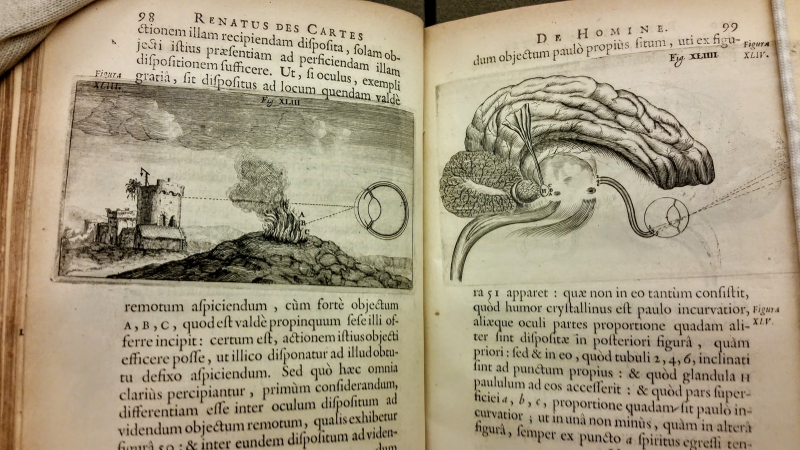
But what really grabbed my attention that day were the illustrations that Descartes designed to accompany the text in these books. I’d seen reproductions of these images in various places, but I had never seen them in their original context, as integral pieces of the written work, designed to illustrate the ideas presented in the texts.
The images are woodcuts and copper engravings, all designed by Descartes, and executed by artisans collaborating with the author and his publishers in Leiden and later Paris. Like the books themselves, they, too, have a hand-crafted aura — well and expertly made, but still very much artisanal objects. The physical work that produced them — the gouging and etching and the inking and rolling — is part of their visual character and impact. One senses immediately that they were produced by someone, copy by copy, page by page.

By way of content, the images are equally fascinating. To the modern eye, they are also a bit strange. Some of that strangeness is owing to the odd combinations and juxtapositions they contain — human organs set alongside geometric figures, eyes set in landscapes — and some of it is due to Descartes’s figuration, which is a bit unnerving. But we recognize instantly the purpose of the images. Descartes was an illustrator as well as a writer. He deployed images as aids to the understanding of his philosophical and scientific arguments. His remarkable, polymathic imagination, embracing mathematics, optics, meteorology, anatomy, and metaphysics, was visual as well as conceptual.

This seems perfectly normal to us. We’re accustomed to visualization in science. Think of the scientific images that have become fixed elements of our visual landscape and culture — the double helix, for example, or the more recent coronavirus. But recall, too, that Descartes’s method begins by insisting on the withdrawal from sense experience in favor of purely mathematical constructions. Why, then, the recourse to illustration and visual imagery? Is illustration a prop in the passage from sense experience to pure reason? Or do images contain something vital and essential to understanding? Do clear and distinct ideas, the holy grail of the Cartesian worldview, require some form of visual embodiment? Can the mind ever really detach itself from the body? Is embodiment essential to thinking?
In his last published essay, Eye and Mind, Merleau-Ponty included a long digression on Descartes’s theory of vision. Descartes’s preference for engravings and woodcuts was no accident, he suggests; it flows directly from Descartes’s conception of space, vision, and light. In Descartes’s rigidly bifurcated world of physical things and mental things, the entirety of the physical universe is a vast mechanism subject to simple and rigid mechanical laws. Space is extension, best conceived, and pictured, as a straight line. Light is a pressure wave transmitted to the eye through an elastic medium; vision is the effect of material forces on our organs. The magic of vision, its ecstatic and revelatory aspect, is illusory. What we see, the image, is a secondary effect of primary physical processes that are entirely mechanical in nature.

As an illustrator, Descartes preferred woodcuts and engravings, Merleau-Ponty contends, precisely because of their austere, black-and-white, two-dimensional linearity. If the understanding requires assistance in grasping the principles that govern the physical world, that assistance ought come in a form that approaches as closely as possible the deeper truth being revealed. Function and line above all else, in other words. No color, no depth, no distraction, no confusion. What Descartes is after in his illustrations is the sparest possible representation of the mechanical nature and function of the things he’s writing about — the eye, the lens, light, and so forth.
Merleau-Ponty notes that Descartes never discusses painting. That’s understandable, as painting engages visual elements and dimensions that are problematic for a purely linear theory of vision — color, for example, and depth. But it’s strange for the additional reason, not mentioned by Merleau-Ponty, that Descartes lived in the Netherlands during the so-called Golden Age of Dutch painting — the time of Rembrandt, Hals, Vermeer, and many others. He was surrounded by painters in a time when painting was a cultural force.

As he did so often across his career, Merleau-Ponty uses Descartes’s theory of vision as a stalking horse on the way to a radically different understanding of painting. Painting is not illustration, copying, imitation, or even representation. It is the visual investigation and expression of vision itself, a visual account of how the world comes to be something visible, something seen. Immersed in sensations of the visible world, the painter attempts to describe how things come into visibility — how an apple comes to be an apple, the bowl a bowl, the pitcher a pitcher, a tablecloth the luminous ground that holds the fruit, the bowl, and the pitcher in its folds. The painting is an “icon” or an “essence,” as he says, “a visible of the second power” that reaches back into the experience of vision to reveal its genesis. The painter wants to catch the visual perception of things in the act, so to speak, as and how they come to be perceived.
Here’s his commentary on Paul Cézanne’s preoccupation with Mt. Sainte-Victoire:

“It is the mountain itself which from out there makes itself seen by the painter; it is the mountain itself that he interrogates with his gaze….What exactly does he ask of it? To unveil the means, visible and not otherwise, by which it makes itself mountain before our eyes. Light, lighting, shadows, reflections, color, all of these objects of his quest are not altogether real objects; like ghosts, they have only visual existence…. The painter’s gaze asks them what they do to suddenly cause something to be and to be this thing, what they do to compose this talisman of a world, to make us see the visible…. The interrogation of painting… looks toward this secret and feverish generation of things in our body.”
The body where “this secret and feverish generation of things” occurs — the body that paints, and the body that stands transfixed before a painting — is clearly not a machine or a piece of extended matter. Merleau-Ponty calls it an enigma. The human body is an uncanny fusion of object and subject, of mind and matter; it is a subject/object, a thing that touches, a thing that sees. “Visible and mobile, my body is a thing among things; it is caught in the fabric of the world. But because it moves itself and sees, it holds things in a circle around itself. Things are an annex or a prolongation of itself; they are encrusted in its flesh; they are part of its full definition; the world is made of the same stuff as the body. This way of turning things around, these antinomies, are different ways of saying that vision happens among, or is caught up in, things — in that place where something visible undertakes to see, becomes visible for itself by virtue of the site of things; in that place where there persists, like the mother water in crystal, the undividedness of sensing and the sensed.”

Standing before a painting, we don’t think enough about the painter’s body. Merleau-Ponty admired the poet Paul Valery’s comment that “the painter always takes his body with him.” Before it becomes a painting, the canvas is a blank tableau, an empty field. The painter’s physical movements gradually fill that emptiness with marks that become recognizable things — faces, bowls, mountains, abstractions. Merleau-Ponty wants us to linger in that extraordinary instant where the painter’s gaze passes into physical movements that become things that have visual life and significance for us. It’s in that miraculous instant — in that transubstantiation, that circuit of eye and mind — that the meaning of painting lies. “In whatever civilization it is born, for whatever beliefs, motives, or thoughts, no matter what ceremonies surround it — and even when it appears devoted to something else — from Lascaux to our time, pure or impure, figurative or not, painting celebrates no other enigma but that of visibility.”

In 1632, five years before Descartes published The Discourse on Method, Rembrandt van Rijn was commissioned to paint “The Anatomy Lesson of Dr. Nicolaes Tulp.” Descartes was living in Amsterdam during this period, and he attended some of Tulps’s lectures. It’s intriguing, to say the least, to imagine Rembrandt and Descartes sitting in the same lecture hall and following the same lecture. It’s also intriguing that Rembrandt apprenticed at an earlier period in his life to Joris van Schooten, a painter in Amsterdam and the uncle of the Dutch mathematician and artist, Frans van Schooten, who lived in Leiden and helped Descartes with the illustrations in The Discourse on Method and its attached essays. A very small world, indeed.
Rembrandt’s remarkable painting is worth a careful look. Dr. Tulp is the primary focus, just to the right and slightly above the center of the canvas. He wears a hat. Beneath him lies a bone-white cadaver, its left arm laid open by a scalpel. With his forceps, Tulp displays the muscles and ligaments running through the forearm to the hand. The cadaver’s exposed arm is dramatically rendered in reds, grays and yellows, in stark contrast to the gray-brown and fleshy hues of the rest of the composition. Huddled to Tulp’s right is a group of seven male observers, each one posed at a slightly different angle to the viewer. No hats. In the lower right-hand corner of the painting is a large book, perhaps Andreas Vesalius’s anatomy text, On the Fabric of the Human Body in Seven Books, opened toward the operating table and the view of its central cast of characters.
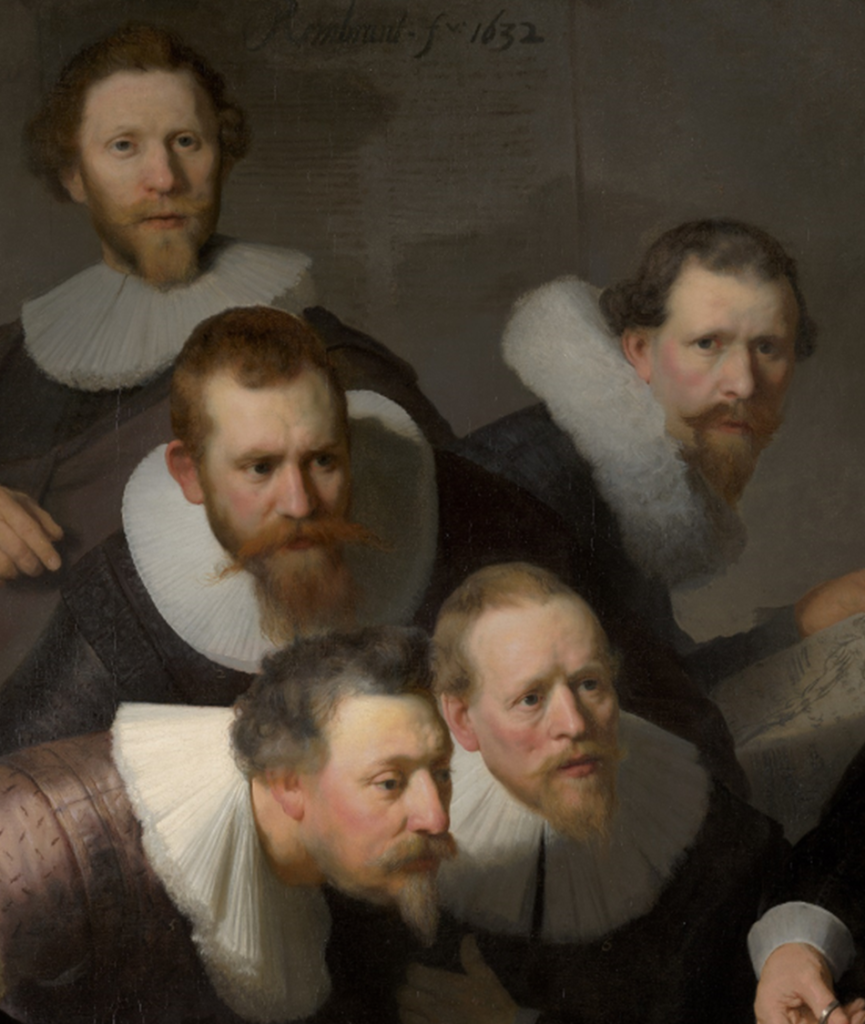
Notwithstanding the painting’s title and the gory, opened arm in the canvas’s luminous foreground, it seems clear on close inspection that the painting is not really about anatomy. It’s about seeing, looking, and being seen. Contextually, we know that these anatomy lessons were public events, conducted in an actual theater, and that Rembrandt would have been compensated for his work by the figures in the painting, all practicing surgeons. The subjects in the painting, all of them male, including the cadaver, are arranged accordingly. Dr. Tulp is not looking at the cadaver. He’s staring off stage right, as if fielding a question, or posing for a painter. The student-observers around Tulp are looking, too. One appears to be looking at the exposed arm, but the rest are looking elsewhere — at the textbook in the lower righthand corner, at members of the implied audience, or — in one case — directly at us, the viewers, who, by way of this glance, become part of the spectacle. In his left hand, he holds an annotated sketch of a standing body, perhaps comparing it to the proceedings, or to Vesalius’s text. Perhaps he, too, is an artist. In any case, his sketch is a kind of mirror for Rembrandt’s creative gaze.
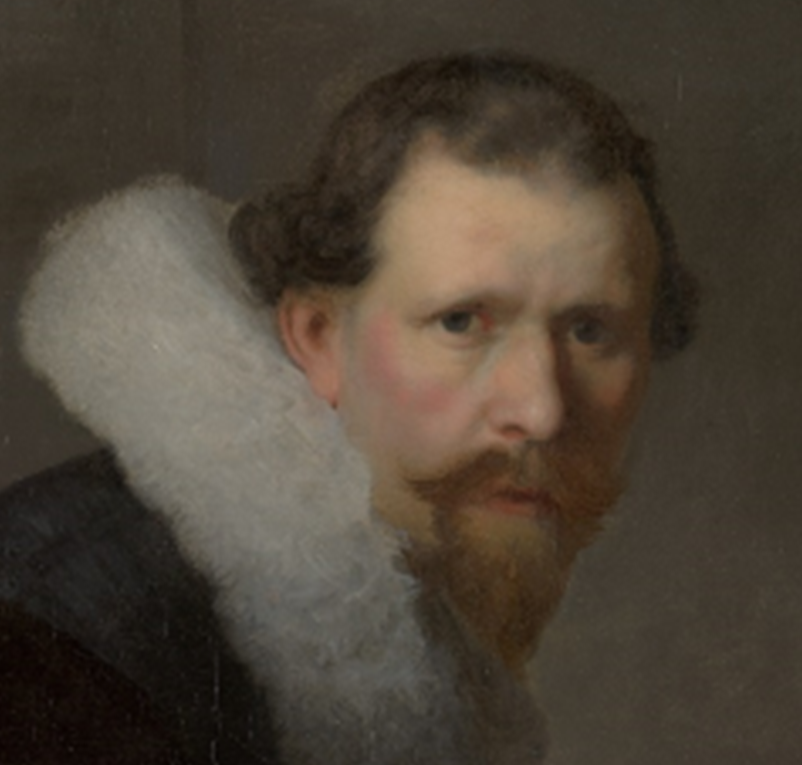
As a study of the interconnected layers and modalities of vision — of seeing and being seen, of looking and being looked at — the painting is dizzying. We see the look of the painter, the look of the primary subject, the look of the secondary subjects, and, implicitly, the look of the audience, invisible but clearly present by inference and by our own looking. And we see in all of these looks the awareness of others looking back. These instances and vectors of vision cross and recross in a kind of infinitely complex regression — seeing, being seen, seeing being seen, being seen being seen, and so on, and on. Rembrandt has created an interworld of seers and of sight, or more precisely an interworld of male seers, where there is no end, no boundary or terminus, no starting or stopping, of vision and visibility. We are a very long way from Descartes’s light waves pressing on the retinas of our eyes and the illustration of those waves refracted by a lens. We are in a place where vision and visibility surround subjects and viewers, present everywhere, voracious, all-consuming.
In addition to being a study in and about vision, “The Anatomy Lesson of Dr. Nicolaes Tulp” is an important document in the history of medicine. And it raises, at least implicitly, important questions about the arc of that history and the relationship of medical science and technology to the experience of both wellness and disease. Advanced medical technologies and the steady march of genetics and molecular and cell biology have led to ever more precise understandings of the human body and to astounding progress in the understanding and treatment of disease. But as the science of medicine becomes increasingly technical and abstract, the lived body, “this body that is mine,” as Merleau-Ponty would have it, recedes, replaced by the body as object, the body as a bundle of chemical, biological processes and forces. In Rembrandt’s stunning depiction, the body as object is rendered as a cadaver, lifeless and pale, a thing to be taken apart. It’s a metaphor, but a powerful and visionary one considering the future evolution of medical science.

Of course, in the actual practice of medicine, the lived body, the patient’s body, “the body that is mine,” can never be completely effaced or objectified. For in the end, medical knowledge, treatments, and cures return to a real person hoping to become or stay well. In brief, medical science and technology must always find their way back to the experience of wellness and disease in the patient’s living body. In that regard, medical science is quite unlike some other sciences, which can reside permanently in highly specialized abstractions. The practice of medicine exists in that place where the body as object and the body as subject coincide, where the language of science must once again rejoin the language of experience.
Merleau-Ponty spent the greater part of his philosophical life looking for ways to close the schisms opened by the Cartesian worldview and to reconnect the body with the mind and the language of science with the language of experience. In painting(s), those connections were never broken. “Essence and existence, imaginary and real, visible and invisible — a painting mixes up all our categories in laying out its oneiric universe of carnal essences, of effectiveness likenesses, of mute meanings.”
Whether we wish it or not, the problem that Merleau-Ponty identified is very much our problem. In our colleges and universities, and in our cultural institutions and practices, the gulf between the natural sciences and the arts and humanities is vast and growing, to the detriment of all parties. We need to be building bridges across this chasm; we need to be seeking out those places and ways in which the extraordinary power and achievements of science can be rejoined to those modes of reflection and knowledge carried out under the banner of the arts and humanities. As teachers, researchers, and administrators working in important cultural institutions, integration should be our watchword.

It’s this kind of integration that has been at the heart of the collaboration between NEH and the National Library of Medicine. It’s a valuable model, but it needs to be developed further. As important cultural institutions, and in the broader sweep of their programming, the NEH and the NLM can play important roles in the project of integration. Both have deep histories of involvement with the educational system in the United States, and both exercise the authority and influence that comes with being national institutions.
Several years ago, the National Academies of Science, Medicine, and Engineering published a report titled Branches from the Same Tree: The Case for Integration in Higher Education. The study was funded in part by NEH and the Andrew W. Mellon Foundation. The title of the report comes from Albert Einstein, who believed that the sciences, the arts, and the humanities are all derived from a common root and that they must be valued, practiced, and promoted with equal energy and commitment. That common root is perhaps less visible now than it was in Einstein’s time, but it’s still there, waiting to be illuminated and celebrated again.
Thank you.

References
Maurice Merleau-Ponty, The World of Perception (London: Routledge, 2004).
Maurice Merleau-Ponty, “Eye and Mind,” The Primacy of Perception, James M. Edie, ed. (Evanston: Northwestern University Press, 1964)
I am grateful to Brian S. Baigrie, historian of science at the University of Toronto, for drawing my attention to Rembrandt’s “The Anatomy Lesson of Dr. Nicolaes Tulp” and for his suggestion that Descartes’s and Rembrandt’s paths may have crossed at Tulp’s lectures. See Brain S. Baigrie, “Descartes’s Scientific Illustrations and la grande méchanique de la nature,” in Picturing Knowledge, Historical and Philosophical Problems Concerning the Use of Art in Science, Brian S. Baigrie, ed. (Toronto: University of Toronto Press, 1996).